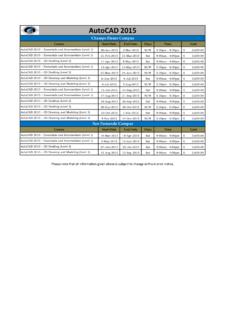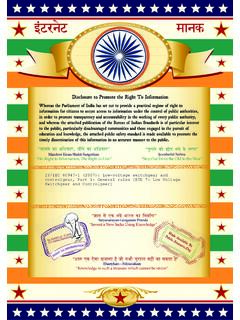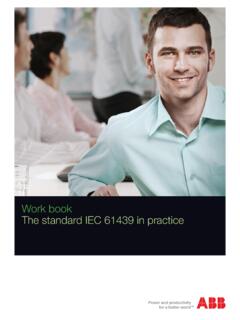Transcription of Unit 2: Construction Technology - School of Business and ...
1 Pearson BTEC Levels 4 and 5 Higher Nationals in Construction and the Built Environment Specification Issue 1 October 2016 Pearson Education Limited 2016 78 Unit 2: Construction Technology Unit code Y/615/1388 Unit type Core Unit Level 4 Credit value 15 Introduction The basic principles of Construction Technology have not changed for hundreds of years. However, the materials and techniques used to achieve these basic principles are constantly evolving; to enable the Construction industry to deliver better quality buildings.
2 Scarcity of resources and the continuing demand of more sophisticated clients, end users and other stakeholder interests, are driving the Construction industry to provide buildings which facilitate enhanced environmental and energy performance, and greater flexibility, in response to ever increasing financial, environmental, legal and economic constraints This unit will introduce the different technological concepts used to enable the Construction of building elements; from substructure to completion, by understanding the different functional characteristics and design considerations to be borne in mind when selecting the most suitable technological solution.
3 Topics included in this unit are: substructure, superstructure, finishes, building services and infrastructure components. On successful completion of this unit a student will be able to analyse scenarios and select the most appropriate Construction Technology solution. Learning Outcomes By the end of this unit students will be able to: 1. Explain the terminology used in Construction Technology . 2. Describe the different techniques used to construct a range of substructures and superstructures, including their function and design selection criteria.
4 3. Identify the different types of civil engineering/infrastructure Technology used in support of buildings. 4. Illustrate the supply and distribution of a range of building services and how they are accommodated within the building. Pearson BTEC Levels 4 and 5 Higher Nationals in Construction and the Built Environment Specification Issue 1 October 2016 Pearson Education Limited 2016 79 Essential Content LO1 Explain the terminology used in Construction Technology Types of Construction activity.
5 Low, medium and high rise buildings, domestic buildings, for example house, flats and other multi-occupancy buildings, commercial buildings, for example offices and shops, industrial buildings, for example, light industrial and warehouses. Construction Technology terminology: Loadbearing and non-loadbearing, structural stability, movement and thermal expansion, durability, weather and moisture resistance, aesthetics, fire resistance, sound insulation , resistance to heat loss and thermal transmission, dimensional co- ordination and standardisation, sustainability and scarcity of availability, on-site and off-site Construction , legal requirements, buildability, health and safety.
6 Construction information: Drawings, specification, schedules, CAD, Building Information Modelling (BIM). Sustainability: Supply chain. Lifecycle. Cradle-to-grave . Cradle-to-cradle . Circular economies. LO2 Describe the different techniques used to construct a range of substructures and superstructures, including their function and design selection criteria Pre-design studies: Desk-top, Site Reconnaissance, Direct Soil Investigation techniques. Substructure functions and design considerations: Different methods for gathering disturbed and undisturbed samples, influence of soil type on foundation design, including water and chemical content, potential loads, position of trees and the impact on foundations, economic considerations, legal considerations (health and safety work in excavations), building regulations, plant requirements.
7 Pearson BTEC Levels 4 and 5 Higher Nationals in Construction and the Built Environment Specification Issue 1 October 2016 Pearson Education Limited 2016 80 Types of foundations: Shallow and deep foundations, strip and deep strip foundations, pad foundations, raft foundations, piled foundations (replacement and displacement piles). Types of superstructure: Traditional Construction , framed Construction : steel, composite concrete and steel, timber. Walls; roofs; structural frames; claddings; finishes; services.
8 Walls: External walls: traditional cavity, timber frame, lightweight steel. Cladding: panel systems, infill systems, composite panel systems, internal partition walls. Roofs: Pitched and flat roof systems, roof coverings. Floors: Ground floors, intermediate floors, floor finishes. Staircases: Timber, concrete, metal staircases, means of escape. Finishes: Ceiling, wall and floor finishes. LO3 Identify the different types of civil engineering/infrastructure Technology used in support of buildings Site remediation and de-watering: Contamination management: cut-off techniques, encapsulation.
9 Soil remediation: stone piling, vibro-compaction. De -watering: permanent sheet piling, secant piling, grout injection freezing, temporary techniques, such as pumping, wells, electro-osmosis. Substructure works: Basement Construction : steel sheet piling, concrete diaphragm walls, coffer dams, caissons, culverts. Superstructure works: Reinforced concrete work: formwork, reinforcement, fabrication, concrete, steel. Pearson BTEC Levels 4 and 5 Higher Nationals in Construction and the Built Environment Specification Issue 1 October 2016 Pearson Education Limited 2016 81 LO4 Illustrate the supply and distribution of a range of building services and how they are accommodated within the building Primary service supply Cold water, gas, electricity.
10 Services distribution Hot and cold water, Single phase and 3-phase electricity, air conditioning ductwork. Services accommodation: Raised access flooring, suspended ceilings, partitioning, rising ducts. Pearson BTEC Levels 4 and 5 Higher Nationals in Construction and the Built Environment Specification Issue 1 October 2016 Pearson Education Limited 2016 82 Learning Outcomes and Assessment Criteria Pass Merit Distinction LO1 Explain the terminology used in Construction Technology P1 Describe the differences between residential, commercial and industrial buildings.






